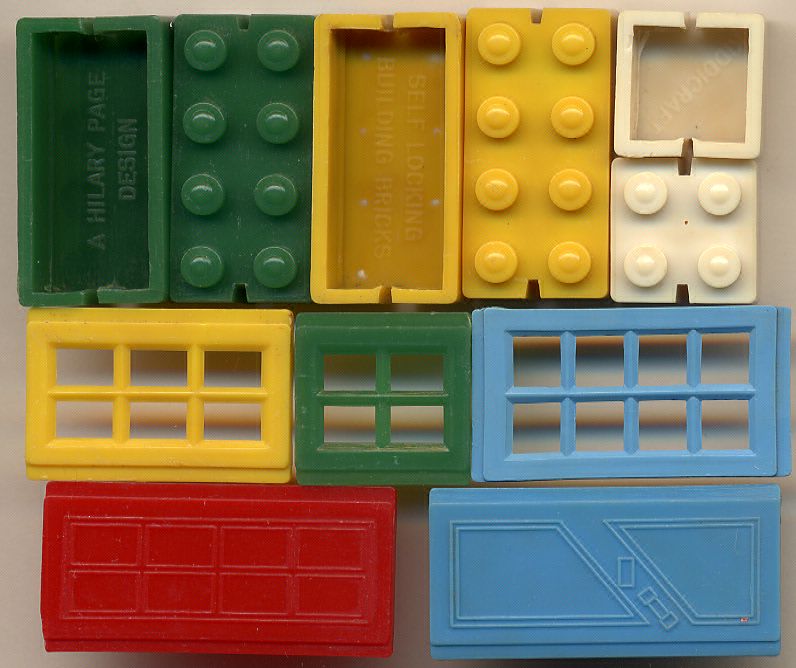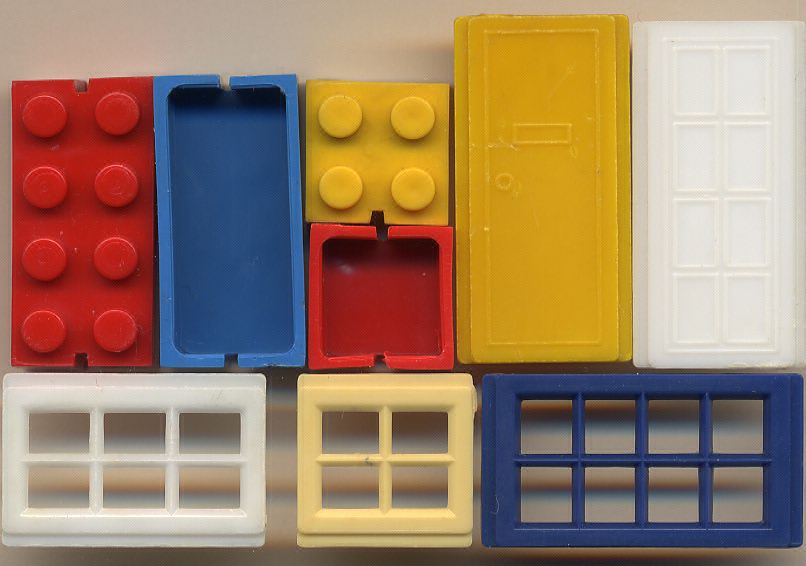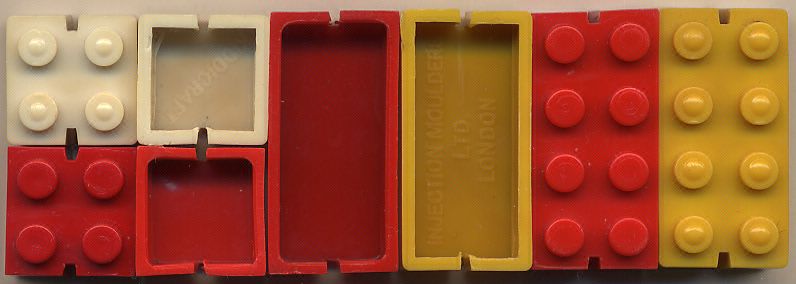|
The Kiddicraft Self-Locking Building bricks are not a LEGO clone; rather LEGO Automatic Binding Bricks are a clone of Kiddicraft's. In the late 1940s Kiddicraft was an English manufacturer of toys managed by its proprietor Harry Fisher Page (aka Hilary Page). Page had an approach to the development of toys that sounds still modern today, starting with an understanding of children psychology. He realized at an early date the value of plastics, infinitely moldable into all sorts of shapes, attractively coloured and virtually nonpoisonous, in the manufacture of toys and introduced the new material in his designs during the 1930s. In 1939 he applied for a patent on hollow plastic cubes with four studs on top (later granted as British Patent Nº.529,580) to allow their positioning atop one another without lateral movement. He called these "Interlocking Building Cubes" and figure 1 shows some such cubes compared to a LEGO 2X4 brick. The interlocking ability was not new, being applied in several construction systems, including the well-known Minibrix, and Harry Page's cubes were only innovative in that they brought together several known concepts embodying them in a plastic shell. |

On December 7, 1944 he applied as "Improvement to Toy Building Blocks" to an addition to the previous patent in which he describes a building system based on rectangular hollow blocks with 2X4 studs on top enabling the construction of walls with staggered rows and window openings, which he illustrated. The addition was granted in 1947 as British Patent Nº 587,206. Finally on June 25, 1945 he applied for a new patent on a construction system using slotted 2X4 and 2X2 bricks that could receive guillotine-like elements such as doors and windows. This capital patent was granted on December 12, 1949 as Nº 633,055.
A less-known but also highly relevant patent was applied for on July 19, 1949 and granted on June 11, 1952 as Nº 673,857. It describes a thin studded baseplate on which the lower row of wall-forming bricks according to the previous patent are mounted so that the finished structure is transportable. The patent is illustrated with examples of 12X17 and 13X13 studs baseplates, both ribbed from the underside to ensure rigidity. The ribs are important because they suggest that at the time of the application, Page had had prototypes actually molded and verified that a reinforcement was needed. This has to have been before August 2, 1950 when the patent application received a last addition. What was presented so far is based on official documents. What follows is partly based on unconfirmed sources, personal memories of people who lived the events or logical suppositions.
Sometime after the patent application of June 1945, Page started manufacturing a construction system that he called "Self Locking Building Bricks" in boxes including 2X2 and 2X4 bricks, four, six and eight-pane windows and doors that were mounted guillotine-like into the brick slots. Some sets also included pictures that could be framed with the bricks. Figure 2 depicts the plastic elements of the system that according to unsourced data was introduced to the market in 1947. A few years later some Kiddicraft boxes also started including a large baseplate.
The Kiddicraft self-locking bricks became known to Ole Kirk Christiansen (OKC), the owner of LEGO, who recognized their value. According to a lawsuit trial statement given by Godtfred Kirk Christiansen in Tel Aviv in 1986, the source of this technological transfer of sorts was the salesman who sold LEGO its first plastics injection machinery. This event probably took place in 1947, when the machine was acquired. However, Page and Christiansen seem to have met in June 1949, probably in Copenhagen, during a trip that Page and his wife did to Sweden and Switzerland with two night stops in Copenhagen. The reason for the trips to Sweden, where the couple went twice in a fortnight, and the themes that may have been discussed there and in Denmark are not known but subsequently LEGO introduced their version of the Interlocking Building Cubes, which was irrelevant, and their version of the Self-Locking Bricks which they named "Automatic Binding Bricks"- figure 3. According to many sources, including LEGO, these were launched on the Scandinavian market in 1949. A close comparison may be made from figure 4 in which all the red bricks are LEGO, and the yellow or white bricks are Kiddicraft. The likeness goes to the point that the molds that produced the LEGO bricks used the same interior ribbing for the purpose of ejecting as did the Kiddicraft bricks.
Shortly after (probably in 1950 or early 1951) LEGO introduced a 10X20 baseplate of its own design. This may be an indigenous idea but is suspiciously like Page's patent of 1949, suggesting that the information about his ideas and designs was indeed not obtained from sets purchased in the market but directly from Kiddicraft or from Injection Moulders, Ltd of London who produced the bricks, because at that time Kiddicraft had seemingly not introduced yet a baseplate to its construction system.
After 1952 the evolution of LEGO is totally endogenous and the way how it came to be the toy of the century is legendary and stems mostly from innovations introduced by Godtfred Kirk Christiansen in 1954/ 55.
 |
| Figure 2- The main elements of Kiddicraft's Self-Locking Building Bricks (above) |
 |
| Figure 3- The main elements of LEGO's Automatic Binding Bricks (above) |
 |
| Figure 4 - A close comparaison between LEGO bricks (all red) and Kiddicraft's (yellow and white) |
APPENDIX: The early history of the LEGO bricks still holds mysteries. The most challenging may be the fact that there are no actual early sources relating LEGO and the Automatic Binding Bricks and the main reason for their attribution to the brand is the fact that after 1951/ 52 both bricks and boxes started being marked with "LEGO". The earlier boxes were either unmarked, or then branded "PRIMA" while the leaflets of sets sold in Sweden were marked "GEAS Konstharts" after the name of a Swedish plastics factory. The construction system was seemingly absent from the LEGO catalogues of the time. And this is all the more surprising as LEGO took pains since an earlier time to brand all their products and has always justly prouded itself of their high quality, of which the Automatic Binding Bricks are most certainly no exception.
There seem to be two possible explanations, the simpler of which is that O.K.Christiansen was afraid he might be infringing patents rights by manufacturing and selling a blatant copy of Kiddicraft's system. Maybe he did not consider that possibility at first (after all, not many patents were taken and everybody copied everybody at the time as a sort of mute tribute to good ideas ), but then, after the investment in molds was done, he may have obtained a Kiddicraft box marked "British and Foreign Patents" and may have been under the impression that he could risk his company if he associated his brand to the toy that he probably expected to last no longer than the time the molds would take to wear and redeem their cost... Actually Page had applied for patents at least in Britain, France and Switzerland (you may find them at this excellent site) but not in any Scandinavian country and thus LEGO could brand the product and pursue its development.
After 1957 the development by LEGO of a novel and efficient locking system would finally allow it to take own patents but the tainted origin would come back to haunt the company in the future. The relevant Kiddicraft patents would one day be acquired by LEGO, but when all patents expired and the rights of LEGO rested on a geometrical shape, again came the argument that the basic shape had not even been actually developed by LEGO. This theme is out of the scope of this text, but those interested may want to consult Jenny Lundahl's Master Thesis on the subject (downloadable from this page). The same source states that Kiddicraft's system was abandoned during the 1950s. In fact it was substituted by a system of the same name with larger bricks and marketed for the very small children. The cubes were also maintained on the catalogue. Sadly Hilary Page, the imaginative inventor who understood children and wrote books to teach those who could not afford his toys to build them themselves, had died in 1957.